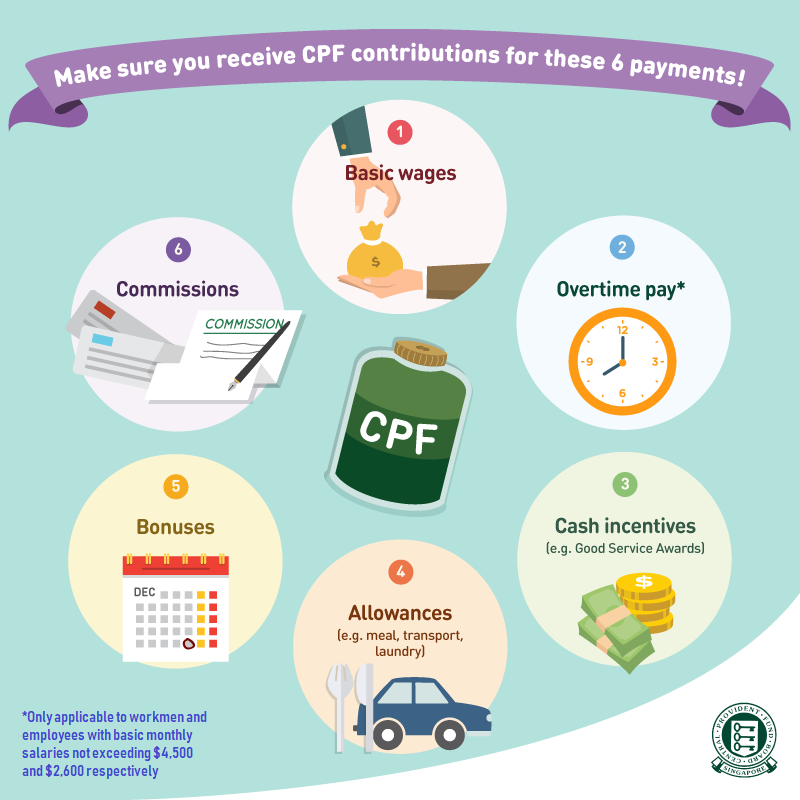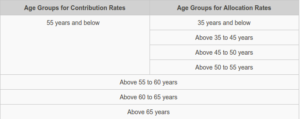Alex Tanglao
Alex Tanglao is a seasoned professional with expertise in startups, legal technology, and business management. Alex has held leadership roles, including Director of Strategy & Operations at Elevate Digital, where he streamlined operations and managed teams, and Director of Ecommerce at Allies of Skin, driving global growth. Alex served as Marketing Manager at Zegal, driving legaltech and educating businesses on startup legal topics. With a background in content strategy from LawPath, Alex combines a deep understanding of legal services with operational excellence and innovative marketing strategies to help businesses thrive in dynamic, fast-paced environments.
Need any help? Contact us:

Table of Contents
Singapore’s Central Provident Fund (CPF) scheme has undergone many changes since its introduction, as an employer with obligations to contribute to your employee’s CPF account, it is crucial that you stay on top of changes to the CPF scheme.
Here, we tell you what you need to know about your employer contribution obligations when it comes to the CPF, for both Singaporeans and Permanent Residents.
What is the Central Provident Fund (CPF)?
The Central Provident Fund (CPF) is a mandatory social security savings scheme funded by contributions from both employers and employees. The CPF primarily goes towards meeting the retirement, housing and healthcare needs of Singaporeans.
Working Singaporeans and their employers are required to make monthly contributions to the CPF, which go into 3 accounts:
- Ordinary Account: Primarily for retirement and housing needs;
- Special Account: Primarily for retirement needs;
- Medisave Account: Primarily for healthcare needs.
When am I required to pay employer CPF contributions for my employees?
If your employee earns more than SGD 50 per month, you are required to pay CPF contributions as an employer. If your employee earns more than SGD 500 per month, you are entitled to recover the employee’s share from the employee’s wages.
Several requirements must be met before an employer is liable to pay CPF contributions for his employee. The employee must be:
- a Singapore Citizen (SC) or Singapore Permanent Resident (SPR);
- working in Singapore under a contract of service; and
- employed under a permanent, part-time or casual basis.
CPF contributions for a SC or SPR working overseas is not mandatory.
A contract of service in this case essentially refers to an Employment Contract that defines the employer-employee relationship, including the terms and conditions of employment.
Learn more about the CPF contribution for employees.
Am I only required to pay employer CPF contributions for my employees’ base monthly salary?
CPF contributions are calculated based on an employee’s total wages. The total wages for a given calendar month is the sum of an employee’s Ordinary Wages (OW) for the month and the Additional Wages (AW) paid to him in that month.
There are different ceilings for OW and AW, which refers to the amount of OW or AW that would attract CPF contributions. It is important to classify the wages correctly as this will in turn affect the amount of CPF contribution payable.
Ordinary Wages (OW)
Ordinary Wages (OW) are:
- wages due or granted wholly and exclusively in respect of an employee’s employment in that month; and
- wages payable before the due date for payment of CPF contributions for that month.
An example of OW is the monthly salary.
The OW Ceiling is capped at $6,000 currently. For example, if an employee’s OW for a calendar month is $6,700, his CPF contribution would be computed based on an OW of $6,000; CPF contribution is not required on the remaining $700.
Additional Wages (AW)
Additional Wages (AW) are:
- wages which are not granted wholly and exclusively for the month; or
- wages made at intervals of more than a month.
Apart from the monthly salary, there are other types of payments which you may make to your employees which may also attract CPF contributions, including:
- Overtime pay (only applicable to workmen and employees with basic monthly salaries not exceeding $4,500 and $2,600 respectively as of 1 April 2019);
- Cash incentives (e.g. Good Service Awards);
- Allowances (e.g. meal, transport, laundry);
- Bonuses;
- Commissions.

Source: CPF Board The amount of CPF contributions payable on AW from 2016 onwards is capped at the yearly AW Ceiling of $102,000 with the total OW subject to CPF for the year deducted.
AW Ceiling = $102,000* – Total OW subject to CPF for the year
The AW Ceiling is applied on a per employer per year basis. Employers are required to monitor and limit the contributions on Additional Wages of their employees. This is to prevent refund of excess payment and avoid situations where refunds cannot be made due to insufficient funds in their employees’ CPF accounts.
To calculate the Additional Wage Ceiling for private sector employees, use the online calculator provided by the CPF Board.
What are my CPF contribution rates as an employer?
The CPF contribution rate applicable for your employee depends on his:
- citizenship – Singapore Citizen or SPR in the first and second year or from the third year of obtaining SPR status;
- age group; and
- total wages for the calendar month.
Unlike contribution rates, the allocation rates applicable for your employee depend on his employee type and age group. There are two key terms that you need to be familiar with as an employer:
- Contribution rate: This refers to the total rate that employers and employees have to contribute to the employee’s CPF.
- Allocation rate: This refers to the various rates that are allocated into the different CPF accounts (namely the Ordinary Account, Special Account, and Medisave Account).
As an employer, you are required to make CPF contributions at the monthly rates stated in the CPF Act. The CPF contribution and allocation rates vary depending on your employee’s citizenship, age group and total wages for the calendar month.
The CPF contribution rates that are applicable would depend on the category that employees fall into:
- Singapore Citizens & Singapore Permanent Residents (3rd Year Onwards)
- Singapore Permanent Residents (first 2 years upon obtaining SPR status)
Category #1: Citizens & SPR
Contribution rates from 1 January 2016 for private sector and public sector non-pensionable employees being:
- Singapore Citizen
- SPR from the third year of obtaining SPR status
- SPR during the first two years of obtaining SPR status but who has jointly applied with employer to contribute at full employer-full employee rates
The current CPF contribution rates applicable to private sector and public sector non-pensionable employees are laid out in the following table:
| Employee’s age (years) |
Contribution Rates from 1 Jan 2016 (for monthly wages ≥ SGD 750) |
||
| By Employer (% of wage) | By Employee (% of wage) |
Total (% of wage) |
|
| 55 and below | 17 | 20 | 37 |
| Above 55 to 60 | 13 | 13 | 26 |
| Above 60 to 65 | 9 | 7.5 | 16.5 |
| Above 65 | 7.5 | 5 | 12.5 |
Please refer to the CPF Contribution Rates Table for Private Sector / Non-Pensionable Employees (Ministries, Statutory Bodies & Aided Schools)
Contribution rates from 1 January 2016 for private sector and public sector non-pensionable employees being:
- Singapore Citizen
- SPR from the third year of obtaining SPR status
- SPR during the first two years of obtaining SPR status but who has jointly applied with employer to contribute at full employer-full employee rates
| Employee’s age (years) |
Contribution Rates from 1 Jan 2016 (for monthly wages ≥ SGD 750) |
||
| Ordinary Account (% of wage) | Special account( % of wage) |
MediSave Account(% of wage) |
|
| 35 and below | 23 | 6 | 8 |
| Above 35 to 45 | |||
| Above 45 to 55 | |||
| Above 55 to 60 | |||
The CPF contribution rates with pensionable and non-pensionable wage components are found in the CPF Contribution Rates Table.
Category #2: First 2 years upon obtaining SPR status
Employers in Singapore are not required to pay CPF for their foreign employees. However, once your foreign employee successfully obtains SPR status, you will have to pay CPF contributions. CPF contributions are payable at lower rates (known as graduated employer-graduated employee contribution rates) during the first two years of obtaining SPR status. From the third year onwards, both you and your SPR employee will contribute to CPF at regular rates (i.e. those set out in Category #1 above).
Please refer to Table A2 (PDF, 0.2MB) for the CPF contribution rates from 1 January 2016 for private sector and public sector non-pensionable employees being SPR during the first two years of obtaining SPR status.
Please refer to Table B2 (PDF, 0.2MB) for the CPF contribution rates from 1 January 2016 for public sector pensionable employees being SPR during the first two years of obtaining SPR status.
Similar to contribution rate the allowances rate can be of two type:
- Private sector and public sector non-pensionable employees
- Public sector pensionable employees
| Employee’s age (years) |
Allocation Rates from 1 Jan 2016 (for monthly wages >= $750) |
||
| Ordinary Account (% of wage) | Special Account (% of wage) |
MediSave Account (% of wage) |
|
| 35 and below | 23 | 6 | 8 |
| Above 35 to 45 | 21 | 7 | 9 |
| Above 45 to 50 | 19 | 8 | 10 |
| Above 50 to 55 | 15 | 11.5 | 10.5 |
| Above 55 to 60 | 12 | 3.5 | 10.5 |
| Above 60 to 65 | 3.5 | 2.5 | 10.5 |
| Above 65 | 1 | 1 | 10.5 |
To determine the CPF allocation rates for all employees including those earning monthly wages of <$750, refer to the CPF allocation rates expressed as ratios of contribution table
| Employee’s age (years) |
Allocation Rates from 1 Jan 2016 (for pensionable wage component only) |
||
| Ordinary Account (% of wage) | Special Account (% of wage) |
MediSave Account (% of wage) |
|
| 35 and below | 17.25 | 4.5 | 6 |
| Above 35 to 45 | 15.75 | 5.25 | 6.75 |
| Above 45 to 50 | 14.25 | 6 | 7.5 |
| Above 50 to 55 | 11.25 | 8.625 | 7.875 |
| Above 55 to 60 | 9 | 2.625 | 7.875 |
| Above 60 to 65 | 3 | 1.875 | 7.5 |
| Above 65 | 0.75 | 0.75 | 7.875 |
You can refer to the CPF allocation rates expressed as ratios of contribution table
What is the age group of your employees?
You have know age matter in CPF contribution as an employer, you need to determine age group of your employees. The contribution and allocation rates are different for different age group to ensure the employability of workers and to meet employees’ needs at various stages of their lives respectively. See table below for the various age groups.
Example
If your employee’s 60th birthday is on 15 January 2016, the CPF contribution and allocation rates for:
- ‘Above 55 to 60 years’ age group will be applicable up till January 2016; and
- ‘Above 60 to 65 years’ age group will apply from 1 February 2016 up to his 65th birthday month.
What should you know about SPR of your employee?
CPF contributions are payable once your foreign employee obtains SPR status. CPF contributions are payable at lower rates (i.e. graduated employer-graduated employee contribution rates) during the first two years of obtaining SPR status.
From the third year onwards, both you and SPR employee will contribute to CPF at full employer-full employee rates (i.e. rates applicable for a Singapore Citizen employee.)
The first year of obtaining SPR status starts from the date of SPR conversion. This refers to the date indicated on the entry permit (Form 5 or Form 5A) issued by the Immigrations and Checkpoints Authority of Singapore (ICA). It ends on the last day of the month of the first anniversary of SPR conversion.
The second year of obtaining SPR status starts from the first day of the month after the month of the first anniversary of SPR conversion. It ends on the last day of the month of the second anniversary of SPR conversion.
A SPR employee in his first two years of obtaining SPR status and his employer can jointly apply to CPF Board to contribute to CPF at higher rates:
-
Full employer-graduated employee rates; or
-
Full employer-full employee rates.
The third year of obtaining SPR status starts from the first day of the month after the month of the second anniversary of SPR conversion.
How do I calculate the CPF contributions payable for my employees?
In order to determine the CPF contribution rates applicable to you as an employer, log on to CPF e-Submit@web, the free web-based application developed by CPF Board that auto-computes the CPF contributions.
What are the consequences if I fail to pay CPF?
Frequent mistakes made by employers when determining CPF contributions include the following:
- Non-payment of CPF contributions for employees under part-time/temporary and/or casual employment’
- Non-payment of CPF contributions for full time employees who have requested not to have CPF contributions so that they can have higher take-home pay;
- Underpayment of CPF contributions when wages are not paid monthly.
Employers who do not comply with the CPF Act may be liable to:
- Late payment interest charged at 18% per annum (1.5% per month), starting from the first day of the following month after the contributions are due. The minimum interest payable is $5 per month.
- A fine of up to $5,000 and no less than $1,000 per offence and/or up to 6 months jail.
- A fine of up to $10,000 and no less than $2,000 per offence and/or 12 months jail for repeat offenders.
- Fine of up to $10,000, imprisonment of up to 7 years or both if you deduct your employee’s share of CPF contributions but fail to pay the contributions to CPF Board.
Important resources about CPF contribution and allocation for employers:







